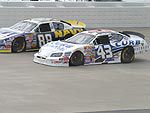
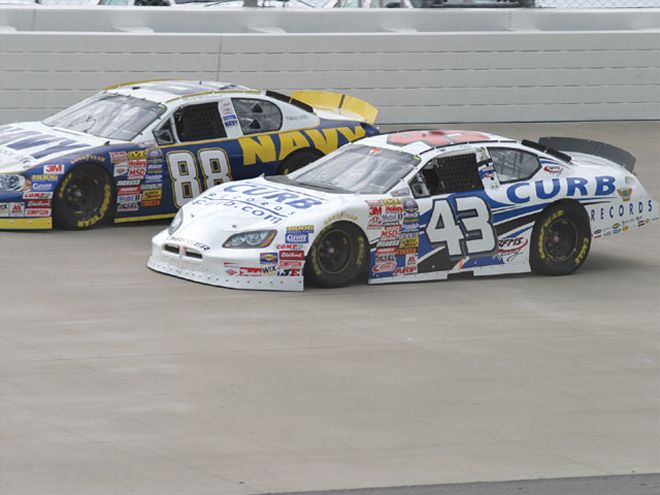 The BBSS setups are easily recognized by the low and level front end while going through the turns, as we see with this 15th-Place finisher, the No. 43 BGN car. Kevin Harvick, in another car, won the race. Similar photos showed a somewhat stiffer setup.
The BBSS setups are easily recognized by the low and level front end while going through the turns, as we see with this 15th-Place finisher, the No. 43 BGN car. Kevin Harvick, in another car, won the race. Similar photos showed a somewhat stiffer setup.
Big Bar and Soft Spring (BBSS) setups are the rage in asphalt racing circles right now. This setup uses a large sway bar combined with soft front springs and a very stiff right-rear (RR) spring. The problem is that you cannot just bolt those parts onto your car and go racing and expect to be successful.
We have talked to teams and component manufacturers about the transition, and we have run those setups in back-to-back tests against conventional setups. In short, we have a lot of information to share.
The very first thing to know is that the BBSS setups are not good for all racetracks. There are some tracks where the gains are significant, others where there is no gain at all, and some where the conventional setups are just plain faster. We'll explain why.
Goals Let's take a look at what our goals might be in going the BBSS route. Most ill-handling cars are traditionally tight and do not turn well. The BBSS setups help the car turn better by forcing additional load onto the left-front (LF) tire.
Handling balance can be accomplished with adjustments to the weight distribution, meaning a change in crossweight. So making the car neutral is not a problem.
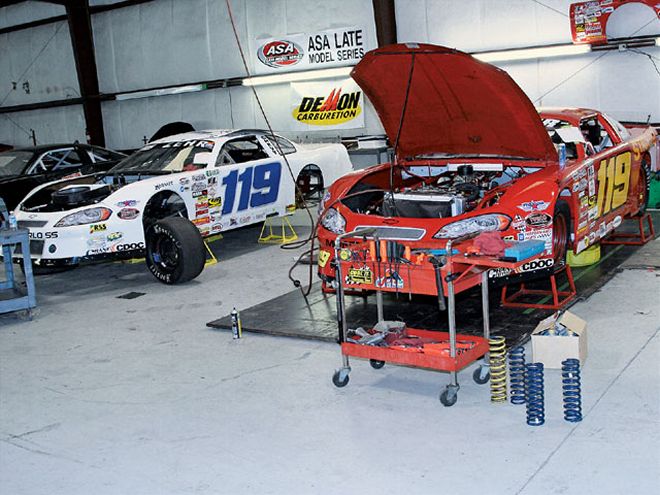 Prepare your car in the shop before you go to the track. Use your old setup first and record all the information. Then put in the BBSS setup and make any necessary changes.
Prepare your car in the shop before you go to the track. Use your old setup first and record all the information. Then put in the BBSS setup and make any necessary changes.
Aero efficiency is improved, sometimes greatly improved on longer tracks, due to the front valence being lower and the rear spoiler being higher. The soft front springs compress more and the stiff RR spring forces the LF corner down to make the front of the car low and parallel to the track in the turns.
Results of the Setup There are some interesting results that come from the transition. First of all, if the car is set up "right," meaning all the way to BBSS (we'll explain what that means later), the dynamic balance is way off. The front wants to roll to 1-1.5 degrees, and the rear wants to achieve a negative roll angle from 0.5 to 1.0 degree.
This difference in desires indicates that a lot of extra load is being put on the RR tire. In older, traditional setups that were unbalanced, the rear outrolled the front and a lot of extra load ended up on the RF tire. That tire soon began to overheat and lose grip. The car either pushed badly or the driver overcame the tight condition with extra steering input until the car went to a tight-loose condition.
The final result was either a worn out RF tire or a burned out RR tire. One of the two was sure to go. So, why doesn't the RR tire give up in the same manner as the RF tire that was overloaded with an unbalanced conventional setup? We're glad you asked.
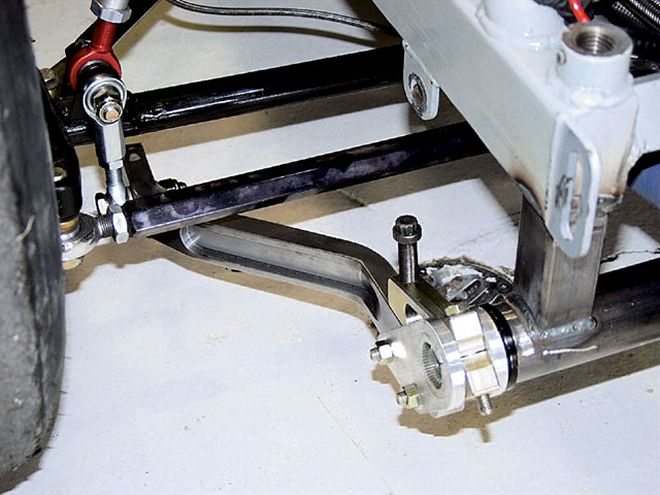 Many teams opt to install the NASCAR-style sway bar mounts instead of the one-piece mount. These mounts are much stronger and offer less friction between the bar and the housing.
Many teams opt to install the NASCAR-style sway bar mounts instead of the one-piece mount. These mounts are much stronger and offer less friction between the bar and the housing.
We pondered the very same question and finally came to a conclusion. When the car is unbalanced, with the rear outrolling the front, the RF tire has to carry extra load, do extra work to keep the car on the track through the turns, and turn the car. This extra duty overloads the tire and causes it to give up.
With the BBSS imbalance syndrome, the RR tire does not have to turn the car. It only needs to keep the rear of the car on the track, and it carries a heavier load to help it.
Since the setup is unbalanced, with the front tires more equally loaded side to side than the rear tires, the front develops more grip. So we see the need to increase the crossweight to tighten up the car. That is exactly what we found when we did a back-to-back test at Florence (South Carolina) Speedway in the ASA Late Model Series South division.
BBSS Components Keeping in mind that there are many variations of the BBSS setups, let's take a look at a common configuration for the straight-rail Late Model cars that usually run a touring series. We will offer general directions, so don't run out and put this in your car. Every car is a little different, and a slow approach to the transition will keep you from getting into trouble.
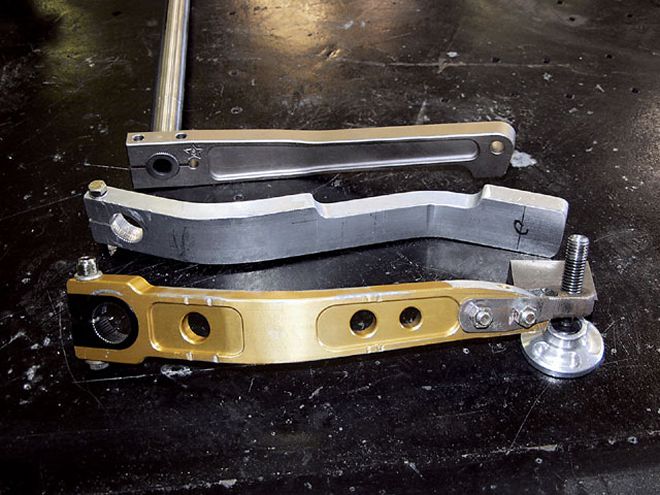 When running a large-diameter sway bar, always try to use steel arms.
When running a large-diameter sway bar, always try to use steel arms.
The sway bar sizes range from 1.375-inch diameter heavy wall thickness, to 1.50 inches, to 2.0 inches and more. For most Late Model cars, 1.50 to 1.75 is common. Some teams think the 1.375-inch bar is large, but it is not when going with the BBSS setup.
Front spring rates vary, from a pair of 150-pound springs up to 225- and 250-pound springs. Again, springs in the 200-pound range are too stiff. The RR spring is usually increased over conventional rates by 100 to 300 pounds. This means you would run a minimum of 250 pounds all the way up to and beyond 400 pounds.
The crossweight must be increased along with these changes. Typical increases are from 2 to 4 percent of total weight. It is often better to begin with the lower crossweight range normally used with stiffer springs and smaller sway bars (for a car with a front-to-rear percentage distribution of 50/50, it is around 51.5 percent cross with a conventional setup) and then add 3 percent or so until the car is neutral in handling.
Since the rear roll angle is a lot less than the front, we also want to lower the Panhard/J-bar about as low as it will go. With most chassis designs, we are limited to going down to 8-9 inches off the ground.
The RR shock will travel about half as much with the BBSS stiff spring in the car, so adjust your trailing arm angle to avoid rear steer to the right in the turns. With a normal travel of 3.5 to 4 inches, we usually use around 1.5-2 degrees of trailing arm angle in the right trailing arm. With the BBSS spring in the RR, reduce that to half, or 0.75 to 1 degree of angle-front high, of course.
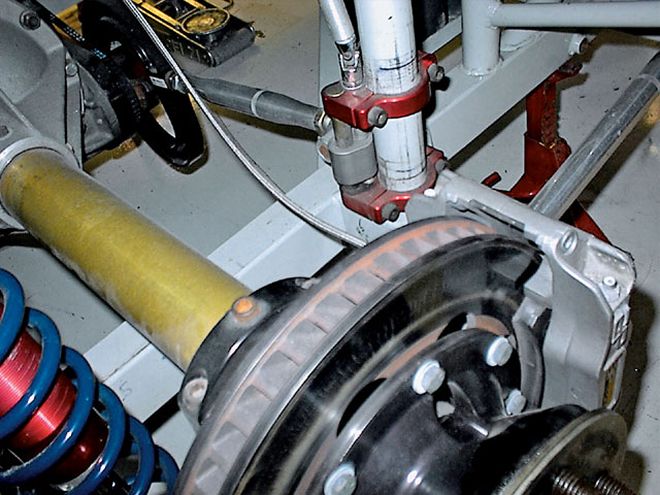 The Panhard/J-bar mounts need to be lowered with the BBSS setups. This one is all the way down on the framerail.
The Panhard/J-bar mounts need to be lowered with the BBSS setups. This one is all the way down on the framerail.
Shock Changes for BBSS One of the biggest changes that must accompany the BBSS setups occurs with the shock rate. The compression settings generally go up at the RF, while those at the LF go down.
The RR might need more rebound to control that stiff spring. Adjustable shocks are very helpful in the tuning stages of the conversion to BBSS.
The amount of increase and decrease in rebound and compression varies with the track size. Long, smooth, and flatter tracks can use much more rebound control than shorter tracks that may be rough. Rough tracks also have a negative effect on the RR when a very stiff spring is used. The car tends to bounce at that corner instead of negotiating the bumps smoothly. It is necessary to reduce the RR spring rate and change the crossweight to bring the car back to neutral handling.
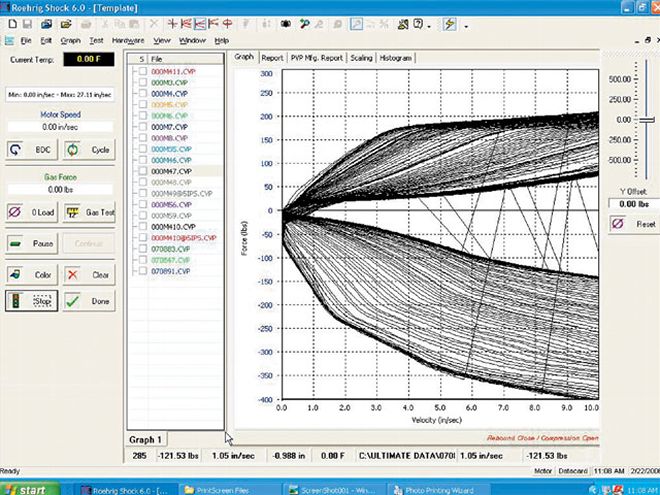 This shock graph represents a Pro-formance shock and shows how much adjustment is available from a double-adjustable shock.
This shock graph represents a Pro-formance shock and shows how much adjustment is available from a double-adjustable shock.
Most of the high-end racing shock companies make shocks that are adjustable. AFCO has released a new canister shock that can be used without the can, and Pro-formance Shocks is very active with the asphalt racers who are using their highly adjustable shocks. Similar designs are available from QA1, hlins, Penske, and Bilstein.
Problems Associated With BBSS Setups We're not done yet, folks. We need to make changes in other areas to accommodate the BBSS setups. The front geometry must be redesigned in order to properly gain the advantages of the BBSS setups. Moment center location is still important, and camber change characteristics are totally different with these setups.
The car dives more and rolls less with the BBSS setup. That means camber changes at the front are entirely different from what we saw with the conventional setups. Both front tires lose lots of camber due to the high dive numbers, 3 to 4 inches in most cases, and low roll angles that normally would counter camber loss in more conventional setups.
The bottom line is that the upper control arm angles need to be reduced. If you had 18 to 24 degrees of upper control arm angle with your conventional setup, you need to reduce it to 12 to 16 degrees while maintaining a decent moment center location.
The static cambers themselves must be altered with the transition. The RF must be reduced from the normal (-) 3.5 to (-) 4.0 degrees to under (-) 2 degrees in most cases, depending on the type of tire used.
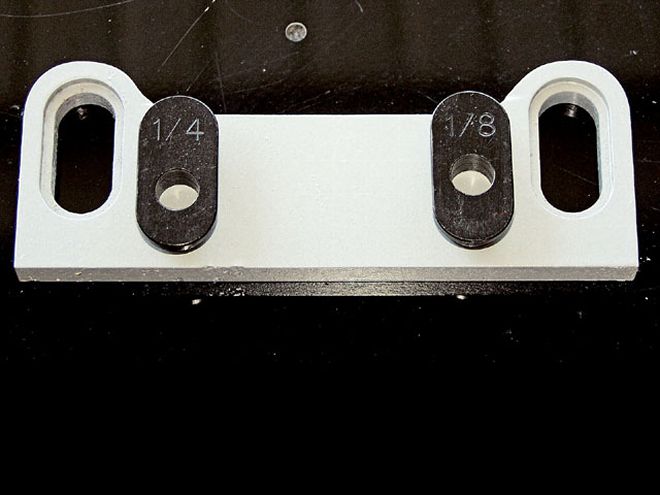 Changes to the upper control arm angles are made easier with these slotted and slugged upper mounts.
Changes to the upper control arm angles are made easier with these slotted and slugged upper mounts.
The LF tire camber must be increased from a normal 2.5-3.0 degrees to 4.0 degrees and more. This tire will lose about 3.5 degrees of camber in the turns.
Ackermann effect is very detrimental to the BBSS setups. If you are accustomed to using some amount of Ackermann in your conventional setups, you cannot run it with the BBSS setups. With the BBSS setup, the LF corner is forced down, and a lot of the front load is carried by that tire. Since it is doing a lot of work, it will compete with the RF tire.
These two tires must track along their proper arcs, tangent to the radius. We have computed and proven that a car running on a short 11/44-mile track needs around 0.100 inch of added toe, or about 0.200 (11/45) degree. On half-mile tracks, that number goes down to 0.040 inch of added toe or less than 0.100 (11/410) degree of toe.
Where to Run BBSS and Where Not To In the past, we've stated that we don't see track records falling from the use of the BBSS setups. About a couple of months ago, someone called to tell us that he switched to the BBSS and broke the record at his track. So, I take it back. But that doesn't mean it works everywhere.
We have proven that the BBSS setups are not meant for all racetracks. In general, the higher the banking at the track, above 10 degrees or so, the less effective the BBSS setups will be. If your track has above 16 degrees of banking, don't even think about it.
Tracks with a rough surface and/or large transitions in banking angle from the straightaways to the turns are hard to manage with the BBSS setups, so you might be better off and more consistent running a more conventional setup.
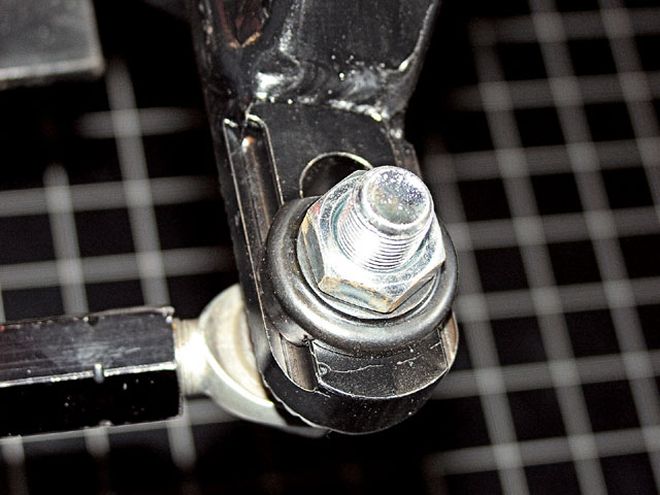 Slotted steering arms allow us to dial in or dial out the Ackermann in our front end. This works as long as we only turn left, as in asphalt racing.
Slotted steering arms allow us to dial in or dial out the Ackermann in our front end. This works as long as we only turn left, as in asphalt racing.
The tracks where these setups shine are the flatter and smoother tracks and the long superspeedways such as Kentucky or Nashville (Tennessee) Superspeedway (not the Fairgrounds). Gateway (Illinois) International Raceway is another good one, and I'm sure similar setups have been used successfully at USA International Speedway in Lakeland, Florida.
Out West, we might see the BBSS setups at tracks like Phoenix (Arizona) or Evergreen (Washington) Speedways. The longer and faster tracks will benefit from the added aero effect to provide more overall grip for faster turn speeds. On 31/44- to 1-mile tracks, that added speed can add up to lap times that are several tenths lower.
Conclusion The choice of setup is entirely yours, so choose your setup based on need. If you are winning a lot with conventional setups, you can experiment during a test session like we did, but not at the event. There's not enough time to properly evaluate the difference.
Watch your shock travels at the RF when using very soft springs. If the frame contacts the track, the car will move quickly to the wall. Make spring changes in a progression rather than one step. Adjust the shocks to fit the transition. Add a little crossweight with each change to maintain the neutral handling.
Once the car is neutral, get good lap times up to 15 to 20 laps and then immediately switch back to the conventional setup and make another run. See which one feels better to the driver and which one is faster. Compare those times with the usual lap times everyone runs. Make a choice and go with it.
If you decide to go with the BBSS setup, go all the way. Use very soft front springs, install a large sway bar, raise the RR spring rate by at least 200 pounds, and adjust your shocks to complement the setup. Good luck, and let us know how it goes.